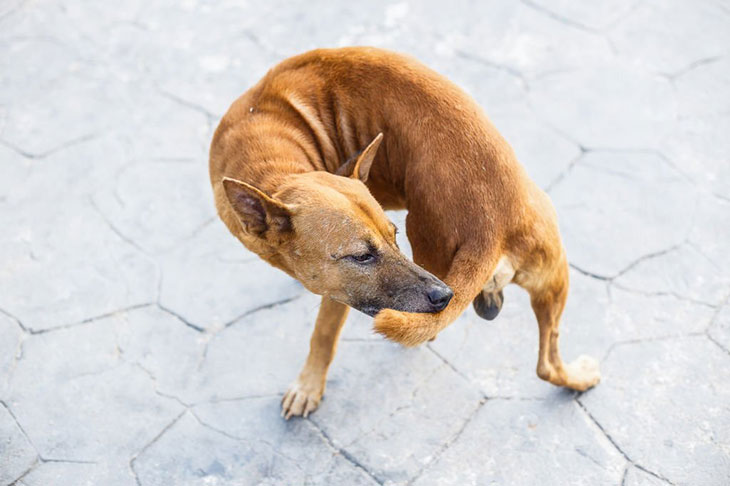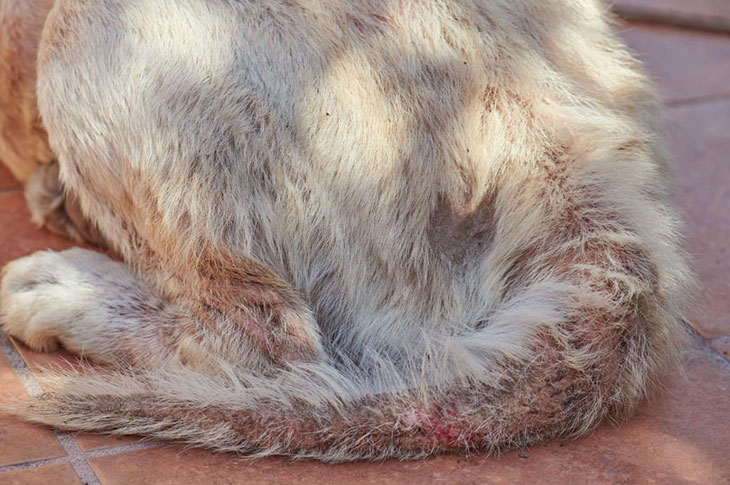Any pet owner would find it upsetting to see the tail-biting behavior of their furry friend.
Why does my dog bite his tail until it bleeds? Both physical health and mental stimulation can be the underlying issues of this perplexing habit.
I can come up with some common symptoms of tail chewing and their causes; thereby, you may know exactly what to do with these repetitive behaviors.
Symptoms of Tail-Chewing Behavior

Tail-chewing behavior in dogs can manifest in various ways; here are some common symptoms associated with ones who hurt their tails.
Uncontrollable Biting
One of the most obvious symptoms is when your dog repeatedly bites, licks, or chews on their tail, frequently to the point of blood and harm.
Hair Loss And Skin Infections
Constant biting can lead to hair loss and raw, irritated skin around the tail area. Patches of missing fur, redness, inflammation, or scabs could be the obvious sign.
Swelling And Inflammation
The tail may swell and inflame as a result of tail-chewing. The area could feel heated to the touch and look bigger than usual.
Changes In Behavior
Tail-injuring dogs can express noticeable changes in their action. They could start to feel anxious, agitated, or restless. Some dogs can show signs of pain or discomfort.
Sores And Open Wounds
If the tail-chewing behavior persists, painful open sores and wounds can develop.
These injuries require dedicated attention for medical treatment; otherwise, the tails may be exposed to skin infections.
Bleeding And Blood Stains
Bleeding from the tail due to excessive biting is a highly possible cause. Blood stains may be on your dog’s tail, fur, bedding, or around their living area.
Why Does My Dog Bite His Tail Until It Bleeds?
A dog biting his tail until bleeding can be due to allergies, parasitic infections from fleas, sticks, etc., secondary infections, hormonal imbalance, stress & anxiety, and obsessive-compulsive disorder.
Allergies
Do you know that dogs can have allergic reactions like us, ranging from food to environmental allergies? The latter, including mold, pollen, and household chemicals, usually explains tail-biting.
Additionally, dogs can develop allergies to certain ingredients like poultry, wheat, potatoes, or certain vegetables.
Additionally, certain shampoos and other grooming supplies might cause allergies in dogs.
It can result in symptoms like swollen, itchy, and irritated skin if your dog is allergic to the components found in the products used for bathing.
To identify the specific triggers, it had better conduct additional tests to determine which type of allergy is annoying your pet.
Parasitic Infestations
External parasites and internal parasites are other common culprits relating closely to the allergic symptoms above.
Dogs may suffer from mites, fleas, or ticks, which can cause allergic dermatitis – an inflammatory skin condition. The symptoms can be more severe and frequent in younger dogs of under 6.
As a result, your pet can bite its tail to relieve the frustrating itchy feelings.
Hot Spots
I recommend looking for a hot spot at a particular area of their skin. Typically, these hotspots happen in warm and humid conditions.
Unfortunately, these environmental conditions make dogs easily prone to secondary infections when bacteria enter the open wound before proper treatment.
Matched hair, hair loss, blood or pus, scabs, or itchy red skin can all be additional signs of hot spots.
Hormonal Imbalances
In certain dogs, a hormonal imbalance can contribute to tail-biting behavior.
When the dog’s body experiences a shortage of thyroid hormone or an excessive cortisol generation, it increases the risk of superficial skin infections.
Stress and Anxiety
When dogs experience heightened stress or anxiety, they may redirect their anxiety towards their tail, leading to excessive biting or chewing.
Tail-biting in response to stress and anxiety can be a coping mechanism for dogs to release their pent-up emotions or to alleviate their discomfort.
Potential triggers could include environmental changes, separation anxiety, fear, feelings of loneliness, or past traumatic experiences.
Developing a tailored behavior modification plan is essential for this case.
Providing a safe and comforting environment, engaging in regular exercise and mental stimulation, and using positive reinforcement techniques may reduce stress and anxiety.
Obsessive-Compulsive Disorder
OCD is an alerting abnormality in the dogs’ mental health. Although the infection rate is rare, you are encouraged to consider it.
OCD in dogs is characterized by compulsive behaviors. They frequently result from anxiety or stress and serve no obvious reason, which makes the treatment more demanding.
Dogs with this mental disorder may develop a fixation with their tails and chase or bite them excessively as long as they get injured.
OCD might be caused by genetics, environmental triggers, or previous traumas.
If you believe your dog may be engaging in OCD via intense tail-chewing, the best way is to consult with a veterinarian.
They diagnose and offer suitable curing approaches, including medication, environmental enrichment, and behavioral modification.
What Are Treatments For A Dog Biting His Tail Until It Bleeds?

Please bear in mind that measures are taken based on particular diseases.
Check And Treat the Injuries
Biting often causes open wounds, bleeding, or burning pain. Therefore, immediately disinfect the injury as soon as you detect it.
A delay in curing can cause contamination by bacteria from the external environment or become more severe due to the constant chewing action from your dog.
Gently clean the wound with bandages, antiseptics, and topical medications.
Eliminating Parasites
Address and treat the problem promptly if your dog has a parasite infestation and is biting its tail. Please take further steps to avoid reinfestation when fleas cause tail-biting behavior.
I start with good hygiene by washing my dog’s bedding in hot water, cleaning my home and furniture, and following a regular flea treatment plan.
Do the same with other pets you keep in your house to prevent the spread of fleas.
Utilizing Medication
Your veterinarian could suggest medication as the treatment approach when underlying issues are present.
Your dog may benefit from topical treatments or oral drugs to improve the health of their skin.
A topical treatment for hot spots can lessen itching, and an anti-inflammatory antibiotic may be recommended for the affected area.
Antibiotics, steroids, or anti-itch medicines may be administered to treat your dog’s allergic response or skin infection.
Ask For Vet Consult
For mental illnesses, a vet’s proper and specific guidance is highly recommended.
As the symptoms of neurological diseases are completely different in each individual, veterinarians will design in-depth measures according to each manifestation of your pet.
How To Prevent My Dog From Chewing Tail Until It Bleeds

Train The Dog With Basic Commands
The dog needs to be aware of tail-chewing or any other destructive behavior to itself, for eg: scratching his private. That’s why you are recommended for a serious training plan.
Use a “stop” or “no” command to interrupt their actions. Once your dog ceases biting its tail in response to the order, reward them with a treat or a toy as positive reinforcement.
If the verbal command is not helpful, please directly and lightly take the tail out of the pet’s mouth.
When you notice your dog starting to touch its tail, redirect their attention by offering playtime or a 15-minute training session.
This will distract them from the tail-biting behavior and provide them with an alternative activity to channel their energy.
Enhance Hygiene
Maintaining a hygiene routine is a top priority, including brushing, bathing, ear cleaning, and nail trimming.
Brush your dog’s coat regularly to remove loose hair, prevent matting, and distribute natural oils.
Please schedule daily baths with vinegar or other dog-specific shampoos or ingredients to keep their coat and skin clean.
Keep your dog’s nails at an appropriate length to prevent discomfort and potential injuries.
Last but not least is to clean bedding and living areas to eliminate the presence of parasites.
Wash or vacuum your dog’s bedding regularly to free it from dirt, odors, and potential allergens like dust, dander, and other debris.
Improve The Diet
A high-fiber diet is advantageous for firmer stools, providing light pressure on the anal glands and promoting the glands to secrete appropriately.
Your dog’s digestive and anal glands’ health can be supported by including enough fiber in its diet.
Make Their Life More Exciting
There are several ideas to enrich your dog’s daily life
For basic methods, you can ensure regular exercise through walks, playtime and agility training.
I also provide my pet interactive toys and puzzles for mental stimulation and engage him in obedience training and mental activities to challenge his problem-solving skills.
Moreover, you can encourage socialization with other dogs and outdoor adventures like hiking and swimming. Do not forget to create dedicated bonding time through grooming and relaxation.
Consider your dog’s age, breed, and preferences for a tailored approach. Incorporating these ideas can make your dog’s life more exciting, fulfilling, and mentally stimulating.
Conclusion
Why does my dog bite his tail until it bleeds? The most popular is allergies or infections, which could fade away with some measures like keeping good hygiene.
But the reason might vary. By understanding the potential reasons behind your dog’s tail-biting, you can take appropriate approaches to address the issue.
Your dog is believed to overcome this act with a proper medical plan, behavior modification techniques, hygiene practices, training, and environmental adjustments.
